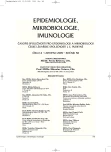Epidemiological Survey of Hepatitis C at the Clinic of Infectology and Travel Medicine in Košice
Authors:
Z. Paraličová
; P. Kristian; I. Schréter
Authors place of work:
Klinika infektológie a cestovnej medicíny, LF UPJŠ a FN L. Pasteura Košice
Published in the journal:
Epidemiol. Mikrobiol. Imunol. 58, 2009, č. 4, s. 158-162
Summary
Introduction:
The study objective was to evaluate epidemiological aspects in patients with hepatitis C treated at the Clinic of Infectology and Travel Medicine in Košice.
Material and Methods:
A retrospective analysis was performed of 232 patients (132 males and 100 females, mean age 43.8 years) followed up and treated with the diagnosis of hepatitis C (HC) in 2003 through 2007.
Results:
The probable sources of infection were most often blood transfusion (in 31 % of patients), injecting drug use (9 %) and invasive medical procedures (6 %). Tattooing and piercing procedures were a potential route of infection in 4 % of HC cases, while other risk factors were less common. None of the HC risk factors was identified in 41 % of HC patients. HCV genotype was determined in 198 patients. HCV genotype 1 was detected in nearly 90 % of the tested HC patients, HCV genotype 3 in 36.6 %, HCV genotype 2 in 3 patients and HCV genotypes 4 and 6 in one patient each. Two HC cases were coinfections with HCV genotypes 1 and 3 or 1 and 4. The mean time interval from the first detection of elevated aminotransferase activity to the diagnosis and therapy institution was 6.3 years.
Conclusion:
The most common source of infection was blood transfusion, followed by injecting drug use and surgery. The prevailing HCV genotype is 1. In the future, it would be necessary to reduce the time interval from the detection of liver damage to the etiological diagnosis of HC, which has been too long.
Key words:
hepatitis C – genotype – risk factors.
Zdroje
1. Global surveillance and control of hepatitis C. Report of a WHO consultation organized in collaboration with the Viral Hepatitis Prevention Board, Antwerp, Belgium. J Viral Hepat, 1999, 6, 1, 35-47.
2. Kiššová, L., Kastelová, E. ed. Výročná správa o stave drogovej problematiky na Slovensku v roku 2006, Národná správa pre EMCDDA. Národné monitorovacie centrum pre drogy. 2007.
3. Marcellin, P. Hepatitis B and hepatitis C in 2009. Liver international 2009, 29, 1, 1-8.
4. Memon, M.I., Memon, M.A. Hepatitis C: an epidemiological review, J Viral Hepat, 2002, 9, 2, 84-100.
5. van der Poel, C.L. Hepatitis C virus and blood transfusion: past and present risks. J Hepatol, 1999, 31, Suppl 1, 101-106.
6. Quan, V.M., Go, V.F., Nam, Ie.V. et al. Risks for HIV, HBV, and HCV infections among male injection drug users in northern Vietnam: a case-control study. AIDS -care, 2009, 21, 1, 7-16.
7. Regionálny úrad verejného zdravotníctva v Banskej Bystrici: Údaje o infekčných ochoreniach na Slovensku. Správa pre NMCD, 2007.
8. Sherlock, S., Dooley, J., et al. Nemoci jater a žlučových cest, překlad 11 vydání, Hradec Králové 2004. 703 s. ISBN 80-86703-00-2.
9. Schréter, I., Kristian, P., Klement, C., Kohútová, D., Jarčuška, P., Maďarová, L., Avdičová, M., Máderová, E. Prevalencia infekcie vírusom hepatitídy C v Slovenskej republike. Klin Mikrobiol Inf Lék, 2007, 13, 2, 54-58.
10. Stramer, S.L. Current risks of transfusion-transmitted agents: a rewiew. Arch Pathol Lab Med 2007, 131, 5, 702-707.
11. Trépo, C., Pradat, P. Hepatitis C virus infection in Western Europe. J Hepatol, 1999, 31, Suppl 1, 80-83.
12. Urbánek, P. Infekce virem heaptitidy C. Remedia, 2005, 15, 1, 75-81.
13. Xia, X., Luo, J., Bai, J., Yu, R. Epidemiology of hepatitis C virus infection among injection drug users in China: systemic review and meta-analysis. Public Health, 2008, 122, 10, 990-1003.
14. Zabransky, T., Mravcik, V., Korcisova, B., Rehak, V. Hepatitis C virus infection among injecting drug users in the Czech Republic – Prevalence and Associated Factors. Eur Addict Res, 2006, 12, 3, 151-160.
15. Zein, N.N., Persing, D.H. Hepatitis C genotypes: current trends and future implications. Mayo Clin Proc, 1996, 71, 458-462.
Štítky
Hygiena a epidemiologie Infekční lékařství MikrobiologieČlánek vyšel v časopise
Epidemiologie, mikrobiologie, imunologie

2009 Číslo 4
- Stillova choroba: vzácné a závažné systémové onemocnění
- Perorální antivirotika jako vysoce efektivní nástroj prevence hospitalizací kvůli COVID-19 − otázky a odpovědi pro praxi
- Diagnostika virových hepatitid v kostce – zorientujte se (nejen) v sérologii
- Jak souvisí postcovidový syndrom s poškozením mozku?
Nejčtenější v tomto čísle
- Pseudomonas aeruginosa, její rezistence k vybraným antibiotikům a tvorba biofilmu u kmenů izolovaných od pacientů s infekcí močových cest
- Dynamika výskytu Creutzfeldtovej -Jakobovej choroby na Slovensku v rokoch 1975-2008
- Sérové protilátky proti endomýziu (AEA) v diagnostickom algoritme celiakie
- Přínos stanovení core antigenu v diagnostice infekce hepatitidy C testem firmy Abbott Laboratories

